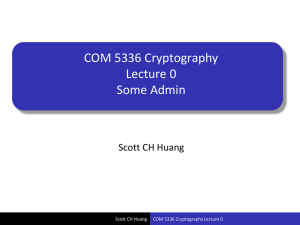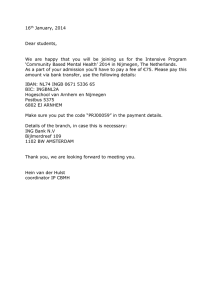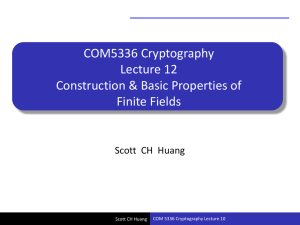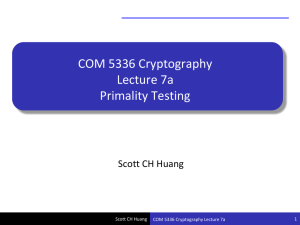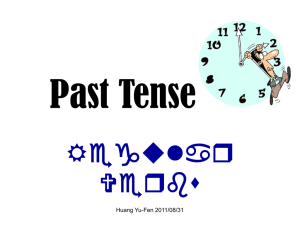Euclidean domain
advertisement
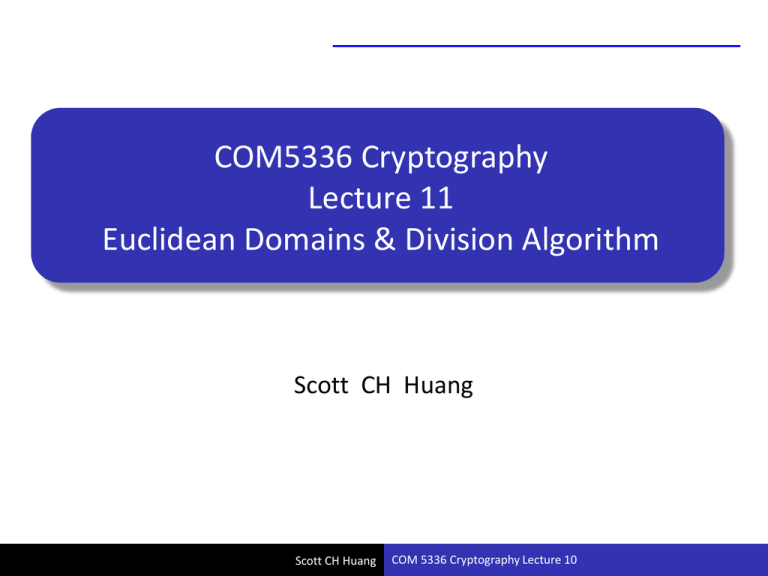
COM5336 Cryptography
Lecture 11
Euclidean Domains & Division Algorithm
Scott CH Huang
Scott CH Huang
COM 5336 Cryptography Lecture 10
Groups
• Binary operations on a set is a mapping
• A set w/ an operation satisfying
1.
2.
3.
4.
Closure
Associativity
Identity
Inverse
• The most fundamental algebraic structure
• Semi-groups: 1 & 2 only.
• Abelian groups: commutative groups.
Scott CH Huang
COM 5336
Rings
• A set R with two operations: + and *.
– +: commutative.
– *: not necessarily commutative.
•
•
•
•
(R,+) forms an abelian group.
(R,*) forms a semi-group (i.e. no identity and inverse)
Distributivity
Ring v.s. Ring with 1 (mult. identity).
Scott CH Huang
COM 5336
Integral Domains
• Domain = Ring w/o zero-divisors
– ab=0 implies a=0 or b=0
– One-sided cancellation law
• Integral Domain = Commutative domain w/ 1.
– Two-sided cancellation law
Scott CH Huang
COM 5336
Euclidean Domains
• A Euclidean Domain is an integral domain with the notion of size.
• The notion of size enables us to apply the Division Algorithm and therefore
Euclid’s Algorithm.
• Size of a≠0, denoted by g(a) is a nonnegative integer s.t.
– g(a)≤g(ab), for all b≠0.
– For all a,b≠0, there exists q,r s.t. a=qb+r, w/ r=0 or g(r)<g(b)
Scott CH Huang
COM 5336
Division Algorithm
• A theorem in mathematics which precisely expresses the outcome of the
usual process of division of integers.
• Its name is a misnomer.
• It is not a true algorithm.
– A well-defined procedure for achieving a specific task
Scott CH Huang
COM 5336
Division Rings
• A ring with unit in which division is possible.
– i.e. every nonzero element has a multiplicative inverse.
• A division ring is NOT necessarily commutative.
– But finite division rings must be commutative (Wedderburn's little theorem).
• A field is a commutative division ring.
– Therefore all finite division rings are finite fields.
Scott CH Huang
COM 5336
Relationship of Algebraic Structures
Ring
Ring w/ unit
Commutative ring w/ unit
Integral Domain
Euclidean
Domain
Scott CH Huang
Field
COM 5336
Division
Ring
Division in a Euclidean Domain
• a|b: ‘a’ divides ‘b’ iff there exists c s.t. b=ac
– a,b,c D, a Euclidean domain.
• If a|b1, a|b2,…, then a is a common divisor of b1,b2,…
• If d is a common divisor of b1,b2,…, and every common divisor divides d,
then d is a greatest common divisor (GCD) of b1,b2,…
• In fact, the concept of GCD can be extended to certain integral domains
called Principal Ideal Domains.
Scott CH Huang
COM 5336
GCD in Algebraic Structures
algebraic structure
requirement
properties
loose
GCD can be defined.
Pricipal Ideal Domain
stricter
GCD can be defined and
exists.
Euclidean Domain
strictest
GCD can be defined and can
be found
Integral Domain
Scott CH Huang
COM 5336
GCD may not exists in an Integral Domain
Note that
Both d1, d2 are common divisors of b1, b2 ,
so b1, b2 has no greatest common divisors.
Scott CH Huang
COM 5336
GCD exists in a Euclidean Domain
• If
, then d can be expressed as a linear
combination of a,b.
• If D is a Euclidean domain and
, then d can be
expressed as a linear combination of a,b
• How to calculate the GCD?
Scott CH Huang
COM 5336
Euclid’s Inspiring Lemma
• gcd(s,t)=gcd(s,t-rs) for all s,t,r in a Euclidean domain D.
• This lemma directly results in Euclid’s algorithm.
Scott CH Huang
COM 5336
Euclid’s Algorithm
int gcd(s,t){
while (s!=0){
u=s;
s= t mod s;
t=u;
}
return t;
}
Scott CH Huang
COM 5336
Theorem #1
Let t be an element in a Euclidean domain D
and m,n be two positive integers. Then
*Hint: (tn-1)-tn-m (tm-1)= tn-m -1
Scott CH Huang
COM 5336
Corollary #1
Let x be an element in a Euclidean domain D and q,n,d
be positive integers. Then
Scott CH Huang
COM 5336
Conceptually
Group
+, -
Ring
+, -, *
Integral Domain
+, -, * and “cancellation”
Euclidean Domain
+, -, * and “division algorithm”
Field
+, -, *, /
Scott CH Huang
COM 5336
Some Examples
•
•
•
•
•
Euclidean domain
ring w/ 1
finite field
commutative ring w/ 1
Euclidean domain
Scott CH Huang
COM 5336
More Examples (cont’d)
• The set
of polynomials over an arbitrary field
with polynomial
addition & multiplication.
• The set
of polynomials with two variables x,y over an arbitrary field
with polynomial addition & multiplication.
Scott CH Huang
COM 5336
Factorization in Euclidean Domains
• We wish to establish a “Fundamental Theorem of Arithmetic” in Euclidean
domains.
• Fundamental Theorem of Arithmetic (aka Unique-Prime-Factorization
Theorem)
– Any integer greater than 1 can be written as a unique product (up to ordering
of the factors) of prime numbers.
• In order to do that, it’s vital to introduce the idea of a “prime number” in
Euclidean domains.
Scott CH Huang
COM 5336
Preliminaries
• Let D be an integral domain. A unit u D is any divisor of 1.
– In the integer ring, the units are ±1. In the Gaussian integer ring, ±1, ±i are
units.
• a, b D are associates if a=ub for some unit u.
– In the integer ring, +3, -3 are associates. In the Gaussian integer ring, 1+ i, 1- i
are associates.
• A factorization of b is an expression of the form b=a1a2· · · ar. If each of the
ai’s are either a unit or an associate of b, this is a trivial factorization.
Scott CH Huang
COM 5336
Irreducible Elements in Integral Domains
• A element p D, an integral domain, is called irreducible iff every
factorization of p is trivial.
• We do not consider units to be irreducible.
• b D. d|b. If d is not an associate of b, then it is called a proper divisor.
• Irreducible elements have no proper divisors other than units.
Scott CH Huang
COM 5336
Primes in Integral Domains
• A nonzero, non-unit element p D, an integral domain, is called prime iff
the following property holds.
– If p|ab, then either p|a or p|b for a,b D.
Scott CH Huang
COM 5336
Primes vs Irreducible Elements
• In an integral domain, every prime is irreducible.
• In a Principal Ideal Domain (PID), every irreducible element is prime.
• In our textbook, only Euclidean domains are discussed. The author did not
distinguish between primes and irreducible elements and regarded them
as synonyms.
Scott CH Huang
COM 5336
Relative Primality
• In a PID, two elements a,b are relatively prime iff gcd(a,b)=1. (remember
that GCD must exists in a PID)
• In a Euclidean domain, if p does not divide a and p is prime, then p and a
are relatively prime.
Scott CH Huang
COM 5336
Some Properties
• In a Euclidean domain, if p does not divide a, then there exist s,t such that
ps+at=1.
• In a Euclidean domain, if a is a proper divisor of b, then g(a)<g(b).
Scott CH Huang
COM 5336
Unique Factorization
• Theorem 3.6: In a Euclidean domain, if b is not a unit, then b can be
factorized as a product of primes:
– b=p1p2 · · · pn
– If b can be factorized in another way as b=q1q2 · · · qn , then after appropriate
renumbering, pi qi are associates for all i.
• In short, Euclidean domains are Unique Factorization Domains (UFD).
Scott CH Huang
COM 5336
Euclidean Domains, PIDs, UFDs
Integral Domain
Unique Factorization Domain
*Principal Ideal Domain*
Euclidean Domain
Field
Scott CH Huang
COM 5336
Example of a non-UFD
• Consider the integral domain
•
•
are irreducible.
Scott CH Huang
COM 5336
